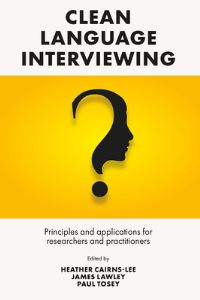Below are Penny Tompkins and my notes from an online Clean Language Practice Group session about referencing nonverbals cleanly which we ran on 11 November 2020.
We introduced the topic by explaining: where the idea of cleanly referencing a person’s nonverbals came from; two types of nonverbals; and how to cleanly reference each type. We followed the introduction with two practice activities. During the debrief the group came up with tips about which nonverbals to select and how best to do that over Zoom.
Historical background
We first saw David Grove demonstrate his approach in 1993, but it wasn’t until 1995 that we started to model him. Between those dates David had gotten interested in a form of nonverbal behaviour that he referred to as a line of sight. He wanted to explore what was happening when a person looked in a direction while they were pondering a question. He wondered, what was going on at the ‘end’ of that line of sight?
From there he branched out into exploring other kinds of nonverbal behaviour such as gestures and also nonverbal sounds (sighs, coughs, Hmm’s). For a period David was interested in the nonverbals that were happening just before a person spoke. He’d ask clean questions of a nonverbal before the client had verbally answered his question!
David discovered that many of the Clean Language questions he’d devised for working with clients’ verbal expressions could easily be modified to address clients’ nonverbal expressions as well.
What was amazing was how much information was enfolded in some of these little gestures. For example, David was doing a demonstration when the client, apparently unaware, tapped his wristwatch three times with his finger while he was speaking. No one else in the room seemed to notice it, but David did. Quick as a flash he asked:
And what’s the first [replicated tap], what’s the second [tap] and what’s the third [tap]?
The client looked down at his watch, tapped it three times, and out poured a mass of information that proved to be a turning point in the session.
Two types of nonverbal behaviour
Nonverbal behaviour and sounds are happening all the time. For example, in our culture many people gesture to in front (or to the right) when they’re talking about the future, and behind (or to the left) when talking about the past. The locations people unconsciously allocate to past, present and future vary between cultures, but all cultures use gestures to separate these timeframes into different locations.
Whether a person is marking out a bit of space with their hands, or using their body to express a metaphor, or using their voice to meta-comment (say with a big sigh) they are expressing experiences which are often out-of-awareness and difficult to put into words.
It is important to recognise the difference between two types of nonverbal behaviour:
One, is when the body expression or sound is itself a metaphor. For example, a client says, “It’s like [making a round gesture with their hands]” or they go “Phew” as if they’re wiping sweat off their brow. We take these nonverbals as symbols, metaphors and meta-comments.
The second kind is when a client uses their body to point to something within their body or perceptual space. Clients use their hands, eyes, head and sometimes their whole body to indicate where things are, and often they do it without much awareness. The client might say, “It’s like it comes out of nowhere” as they gesture and slightly turn to their left. Or they say, “There are three of things I need to do” and they mark out the location of each one with a hand gesture.
Some nonverbals are so obvious that they’re easy to notice; crying for example. And some, like the watch-tapping example, are so subtle they take a trained eye to spot. Given people are expressing themselves nonverbally all the time, there is a great skill involved in picking out the ones that seem to be most significant to the client. There are guidelines, but to a large degree an in-the-moment, intuitive sense needs to be developed.
Referencing nonverbal behaviour
As a facilitator you need to recognise the difference between these two kinds of metaphorical nonverbal behaviours because you reference them in different ways. The two primary ways you can cleanly reference the two kinds of metaphorical nonverbal behaviour is by:
Using your body and voice to replicate the client’s nonverbal metaphor
or
Pointing to where the client has nonverbally marked out the location of a symbol in their perceptual space.
One of the many great advantages of Clean Language is we don’t need any idea what the symbol being expressed or pointed to is, we don’t need to know what it means, and we don’t need its name to be able to ask a clean question of it.
The two take-home messages for facilitators making use of client nonverbals are:
First, to reference or point to a symbol that as yet does not have a name, you will either need to replicate the client’s nonverbal expression, or you will need to gesture or in some other way point to its location.
And second, you have to reference nonverbals at the moment or soon after they happen because they have, what David Grove called “a short half-life”. (“Half-life” is the time it takes for something to decay. The shorter the half-life, the sooner it ceases to exist.) Because of the short half-life, if you leave your question until after the client has finished processing or speaking they may well have lost their connection to the nonverbal.
Practice Activity 1
In 3’s, 5 minutes each round (5 x 3 = 15 + 10 mins debrief = 25 minutes in total). This activity can also be done in pairs.
Note: In this activity the ‘client’ only answers nonverbally.
Facilitator: And what would you like to have happen?
Client: [Responds with a nonverbal answer, gesture, expression, sound.]
Fac.: Asks one of the following questions of the client’s nonverbal:
Common Clean Language questions used to reference a nonverbal (NV):
Symbol
And what kind of [replicate NV]?
And is there anything else about [NV]?
And when [NV] what happens to …?
Event
And what happened just before [NV]?
And then what happens?
And where could [NV] come from?
Location
And whereabouts is [point to general location of the symbol]?
And what’s happening there [point to body part or location]
And where are you going when you go there [gesture along line of sight]?
Know
And what does that [point to NV] know?
And what does that [name body part, e.g. hand/foot] know?
Client: [Responds with a nonverbal answer, gesture, expression, sound].
Fac.: Asks another question from the list of the client’s nonverbal.
And so on for 5 minutes.
Swap roles.
Debrief: What worked well?
Practice Activity 2
In 3’s, 7 minutes each round (7 x 3 = 21 + 10 mins = 30 minutes in total). This activity can also be done in pairs.
Same format as Activity 1 but this time the client answers with words.
The facilitator is going to try to reference a nonverbal as soon as possible (interrupting the client as necessary).
You don’t need to ask about a nonverbal with every question, but aim to ask as many as possible (and that the client can take!)
You can also make use of: And that’s [replicate NV] like what?
Swap roles
Debrief questions to consider:
What worked well?
What prompted you to select a particular nonverbal?
What’s the difference between working with gestures and nonverbals on Zoom, compared to working face-to-face?
What adjustments did you need to make?
Tips on which nonverbals to select
When the client keeps repeating a gesture or sound.
When it appears the client’s NV is expressing what they are speaking about, e.g. Talking about holding down emotions while patting the arm of chair.
When the client’s body is doing something that’s not being described verbally, e.g. a big sigh, apparently pointing to something else.
- When the client uses a line-of-sight:
- A long-held gaze off into the distance.
- A sudden unusual line of sight for this client, e.g. they consistently look to their left while thinking about an answer, but then suddenly look to their right.
Tips when using Zoom
You might ask the client to sit further away from the camera so you can see more of their body.
You might need to catch their attention for them to notice what you are doing, e.g. use a strong “And” at the beginning of your question.
You may need to make your pointing more obvious (e.g. bigger gestures), but remember to keep them within the frame of the Zoom screen.
You may need to repeat your question (without explaining).







